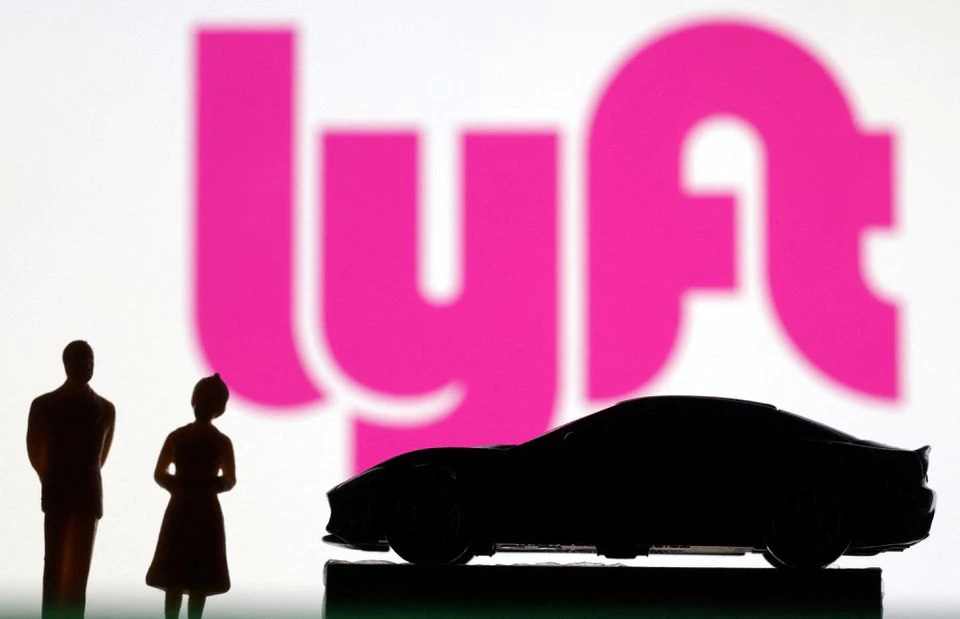(Reuters) – Lyft beat estimates for quarterly profit on Tuesday and said it would generate positive free cash flow for the first time in 2024, as it cut costs and became more competitive with larger rideshare rival Uber.
Shares were up 17% in late afterhours trade, despite a major gaffe: Lyft’s said incorrectly in a statement that a key margin metric was expected to rise by 500 basis points this year. On a conference call later, Chief Financial Officer Erin Brewer corrected the forecast to an increase of 50 basis points.
Stock had surged 67% based on the statement and lost most of the gains after the correction.
Roughly 47.8 million Lyft shares changed hands in after-hours activity, according to Nasdaq. That surpassed the stock’s average daily volume of about 13.6 million shares in the last 50 regular trading sessions, according to LSEG data.
“(The surge) included a significant amount of short covering from hedge funds who are heavily involved in shorting this name,” said Adam Ballantyne, senior analyst at Cambiar Investors, which holds Uber stock.
Roughly 13% of Lyft’s free float stock were shorted as of Jan. 31, verus a 3% short interest in Uber.
Jake Walker, a securities lawyer at Block & Leviton, said the mistake could spark lawsuits as investors tried to recover losses.
Still, as share gains settled late evening, investors focused on CEO David Risher’s efforts to cut costs.
Risher, who took over the reins at Lyft less than a year ago, has driven aggressive restructuring, including eliminating management layers. The early efforts fueled a 36% surge in Lyft stock in 2023.
“As we can drive our scale north and hold our costs flat, we’re going to drop more money to the bottom line,” Risher told Reuters in an interview.
Lyft cut total costs last year by 12%, from a year earlier, compared with a 28% surge in expenses in 2022.
Rides to stadiums grew more than 35% last year from 2022, mainly driven by Taylor Swift’s Eras Tour, Beyoncé’s Renaissance World Tour and other sporting events, Lyft said.
“The strong outlook indicates the ride-hailing company may finally be coming out of the woods,” said Jesse Cohen, senior analyst at Investing.com. Uber shares rose 2% after Lyft’s results.

DRIVER PUSH
Lyft retained its 29% market share in the fourth quarter, fending off Uber by keeping prices competitive, according to market analysis firm YipitData. Though Uber dominates the industry, analysts believe Lyft will remain a strong second player.
Lyft’s gross bookings grew 17% to $3.7 billion in the fourth quarter. It expects between $3.5 billion and $3.6 billion in gross bookings in the March quarter, above analysts’ estimates of $3.45 billion.
Earlier this month, Uber posted its first annual net profit as a public company as gross bookings and user retention improved, and it benefited from initiatives like memberships, corporate travel and advertising.
Risher, too, said on Tuesday growth this year would be driven by partnerships with companies including LinkedIn and Starbucks.
Last week, Lyft, which has a strong presence in the West Coast, announced it would pay the difference if drivers made less than 70% of what riders paid after external fees every week.
In the second half of 2023, the median earnings for a Lyft driver using their personal vehicle was $30.68, including tips and bonuses per engaged hour. For Uber, it was $33 per hour, in the December quarter.
“Lyft is trying to earn less money from the drivers in order to grow the amount of driver pool that they have and to grow the amount of passengers that they want to drive and Uber is doing the opposite,” said Cambiar’s Ballantyne. “This is a huge gamble for Lyft because they make very little money as it is.”.


Reporting by Akash Sriram in Bengaluru, Additional reporting by Noel Randewich and Abhirup Roy in San Francisco, and Lance Tupper and David Gaffen in New York; Editing by Anil D’Silva and Sayantani Ghosh











